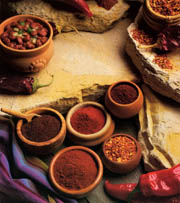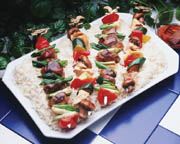
The African continent makes up about one-fifth of the total land on earth. The northern countries on this massive continent are Morocco, Algeria, Tunisia, Libya and Egypt. While they are host to a diversity of cultures and religions, they also have much in common, especially in the areas of culture and cuisine. The Romans, Phoenicians, Arabs, Spaniards, French and other invaders or peaceful settlers in these countries have had important influences in the area.
The majority of the people in North Africa practice the Muslim religion, which means they follow the dietary rules set down by the Koran and its interpreters. While eating pork is forbidden, there are plenty of alternative meats and poultry, and seafood dishes seasoned with great tasting herbs, spices and condiments.

A Colorful Lot of Spices
Food ingredients and cooking techniques are very similar in North African countries. However, it is the seasoning and flavoring of the foods that sets regions or countries apart from each other. Some flavor staples used in many dishes are caraway, coriander, cinnamon, cumin, fennel, ginger, mace, mint, red pepper, rosebuds, saffron and white pepper.Spice mixes such as Ras el Hanout (a Moroccan spice blend that contains anywhere from 15 to 30 spices such as allspice berries, ground cayenne, cassia bark, cardamom, cut galangal, cinnamon, black pepper, ginger, lavender, turmeric and rosebuds), and curry powder are used quite a bit. However, the exact combination, mixture and quantity of ingredients varies from country to country, and cook to cook. Basic ingredients found in curry powder are chilies, coriander, cumin, ginger, mustard powder, saffron and turmeric.
Condiments include those such as Harissa (a hot sauce made with powdered chilies, garlic, olive oil and salt), and Egyptian salad dressing (made with olive oil, freshly squeezed lemon juice, vinegar, garlic, cumin, salt, black pepper and preserved lemons). The lemon slices are seasoned with salt (or ground coriander) and olive oil, and then aged for a few weeks.
The Flexibility of the Tagine
The tagine is a cooking essential used to cook many traditional North African dishes. It has a shallow bottom that can be used as a serving dish, and the top is cone-shaped and pierced with a hole near the top. This keeps food hot, while allowing steam to escape through the top. The open spout helps prevent food from becoming soggy.
Foods such as chicken, fish, pigeon, mutton, beef, goat, vegetables and fruits, all cook well in a tagine. Most recipes call for the tagine's shallow base to be oiled first with olive oil or smen (an aged, rancid butter similar to ghee, a type of clarified butter that is a mainstay in Indian cooking). Then, the rest of the ingredients are placed on the shallow base of the tagine. While traditional tagines are designed to be used on a charcoal fire, those that can be used on a gas stove or electrical burner also work well.
More Traditional Fare
Typical North African meals start off with soups, even for breakfast. Soups are sold as breakfast in the early morning on the streets of large towns and cities. They can be as simple as a vegetable broth or as complex as a lentil and fava bean soup, and are made with onions, tomatoes, ground ginger, ground cinnamon, ground turmeric, saffron threads, cilantro, parsley, salt, black pepper, lentils, fava beans and egg noodles.Bread usually accompanies every meal. Most housewives still prepare their own bread before sending it to be baked in the neighborhood oven. The dense, round loaves of bread (sometimes called akersa or khobz) are the preferred choice. However, the French baguette continues to become more popular, far beyond the Moroccan borders.
Simmering or stewing the ingredients in a tagine or large cast iron pot is how main dishes usually are cooked. There also is the traditional way of cooking food over an open fire or charcoal. Typical grilled vegetable kabobs, made Moroccan-style, are prepared over charcoal. First, cooks make a Charmoula sauce, which also can be used as a marinade and includes ground cumin, fresh lemon juice, salt, black pepper, sweet paprika, ground ginger, fresh marjoram, cilantro and olive oil—all mixed together. The kabobs are made with pieces of meat and freshly cut cauliflower, zucchini, eggplant, bell pepper, fennel buds and pearl onions. Grilled vegetable kabobs are served over couscous or rice flavored with ground cumin.
It is not customary to eat desserts in North Africa. In fact, this habit is practiced throughout most of the continent. Most times, a bowl of fresh fruit becomes the dessert at the end of a meal. Sweets are served at festive occasions or when guests drop by for a visit. They usually are some type of sweet pastry stuffed with nuts and covered in syrup. Fried honey puffs are popular, and they consist of a sweet egg-flour batter deep fried in vegetable oil, then covered with honey. The honey is flavored with orange juice and orange-flower water.
Because most people in North Africa follow the dietary rules of the Koran and its interpreters, alcohol is prohibited. However, serving coffee and tea is an important social activity. Usually, men gather in cafés to drink strong coffee, often flavored with cardamom, in tiny cups.
Also served in North African cafés is Chinese Gunpowder Tea. This hot tea is served in small glasses, sweetened with lots of sugar, with fresh mint added. Toasted pine nuts or roasted peanuts are served on the side.
Snacking is a Western hemisphere habit and, therefore, not a regular part of North Africans' routine. However, sometimes, dates or a piece of fruit are nibbled on between meals.
The North African cuisine features intricate blends of spices and seasonings, and will appeal to the wide audience of Americans searching for ethnic, tasty cuisines. From the ingredients used to prepare the cuisine, to the interesting use of the tagine, North African cuisine has a lot to offer curious culinary adventurers.
Plus: A Tip on Grains
Millet is as important to Africa as wheat is to America. Millet is a cereal grain that has a bland flavor, which can be eaten as flakes or ground into flour. There is a North African custard food called Millet Porridge, which is made with millet flour, confectioner's sugar (to taste), water, orange-flower water and ginger for flavor—all combined and boiled a few minutes, then cooled down and served and eaten as a custard.There are many main dishes in North Africa that use rice, mostly white long-grain rice. However, couscous is used more. Couscous is made from cracked durum wheat, or semolina, that has been rolled into tiny pellets. Most Americans do not realize that couscous is a pasta, not a grain—although it is made from wheat, which is a grain.
Pre-prepared couscous can be found in most North African markets and in most of the Americas' supermarkets and grocery stores. Pre-prepared couscous only requires pre-soaking and steaming for a few minutes. The traditional way of making couscous is just as time consuming as making pasta from scratch, including the “drying-out” stage.
Americans eat couscous mostly over salads and as side dishes. However, in North Africa, couscous is served as the main dish—sometimes with vegetables or meats such as lamb or beef.